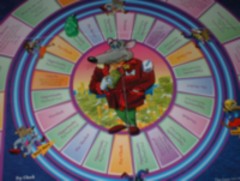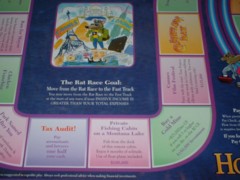|
Cash flow 101...What can you learn from It?A rival to Monopoly, Cash Flow 101 is gaining acceptance and strong support throughout the richdad community. This product was created and designed by Robert Kiyosaki back in 1996 to teach people about money and investing.
What's so special about this board game?
A lot of people asked this question, "Is Cash Flow 101 really good?"
Well, I've bought the game back in 2003 and decided to try it myself.
Game contents
Let's look at the contents of Cashflow 101 in a nutshell:
Gameplay Basics
The boardgame is divided into two tracks. One is called the "Rat Race" (the circular track) and the other is called the "Fast Track". The game has two objectives:
a)The first one is to move from the rat race and onto the fast track. You do that by accumulating enough income producing assets (passive income) to exceed your monthly expenses
b)Once you move to the fast track, your next goal is to land on your dream space (which you had chosen earlier) or reach the $50000 mark in passive income to win the game.
4 main deck cards
Instead of having "chance and trasure chest" deck cards in Monopoly, you'll have 4 different decks in Cash Flow 101. Let's look at each of them:
a)Small Deal
This opportunity card contains investments such as stocks, businesses and real estate that costs $5000 or below
b)Big Deal
Big deal cards have investments that costs $6000 or more. Examples of big deals are apartments, 8 plexes, and large businesses.
c)Market
The market shows you the events of the game such as business opportunity or trends.
d)Doodad
These are unnecessary expenses that you have to spend. When you land on this square, you have no choice but to pay for it. Examples of doodads are sunglasses, tv, boat, etc.
The "Rat Race"
Before you start, you need to choose an occupation card (a job) and input the financial details into your game card. Jobs can vary from janitor to doctor, each having its own income and expenses.
You also need to assign the role of a banker to other players or assume the role yourself.
The game has different types of squares, with each of them presents opportunity to draw one of the four deck cards
Of course you have the usual "paycheck square" which is similar to "GO" in Monopoly where you collect your salary everytime you land or pass through (you have to ask for your salary or it's gone)
Be wary of the "downsized" square. When you land on it, you'll temporarilly lose your job, pay an amount equals to expenses and lose two turns. You cannot collect your paycheck during this period.
The "charity" gives the player option to donate 10 percent of the monthly salary and get to roll two dices in the next three turns.
Then there is the "baby" square where you have a new baby and therefore have to pay monthly expenses for your child. It can really eat up your cash flow. The game allows up to 3 children per player.
The "Fast Track"
Unlike the rat race, you don't have jobs in the fast track as all of your income comes from either in businesses or investments.
Things are a little different from here as there are larger opportunities and more cash involvement.
However, you also get a higher paycheck when you land or pass through the "cashflow day" square. The amount of cash you collect depends on the passive income that you carried over from the "rat race" except that it is now multiplied by 100.
Eg. If your passive income is $2000, then your "cashflow day" income is now $200000.
Your next objective is to buy assets that generates a minimum of $50000 in passive income. These assets are large businesses, large real estate deals, or IPO stocks.
Or you could win if you land on your chosen dream vacation.That way you don't have to buy assets.
Besides investments, cash flow 101 also allows you to buy other dreams and philanthropic squares when you land on them. when you land on them. Since you are now financially free, you can have the freedom to spend or give back to the community.
Examples of these squares vary from golfing around the world to developing a cancer research center.
There are also squares such as lawsuits, tax audit and divorce that costs you to lose half or all of your cash.
I must say this level is much easier as you just have to convert your cash into... more cash!
Summary
Is Cash Flow 101 right for you?
It depends. Although it is primarily an educational board game, the product is really quite expensive (about $195). (Update: There is a new version and the price is now around $80)
So if you're not motivated, don't like to play games or don't have the desire to change your financial future, then Cashflow 101 is not right for you. Instead read Rich Dad books or other publications about investing.
Besides, the more people playing cash Flow 101 the better the interactivity. (maximum of 6 players). So make sure your friends or relatives share the same interest with you.
A word of caution. The cash Flow boardgame does not provide legal and investment advice, only basic financial education.
For those of you who really need to improve your vocabulary on investing or have a strong desire to move from the real "rat race" to the fast track, Cash Flow 101 can really help you get started.
If you're interested you can also join the cashflow clubs or find players in your local area.
You can know more about Cash Flow 101 here
|
 Playing cash flow 101 is quite a challenge for the first time as you need to fammiliarize yourself with the game card. The game card is where you make changes to your financial statements throughout the game.
Playing cash flow 101 is quite a challenge for the first time as you need to fammiliarize yourself with the game card. The game card is where you make changes to your financial statements throughout the game.
 Once you successfully have more passive income than your expenses, then you automatically qualify to this level.
Once you successfully have more passive income than your expenses, then you automatically qualify to this level. 